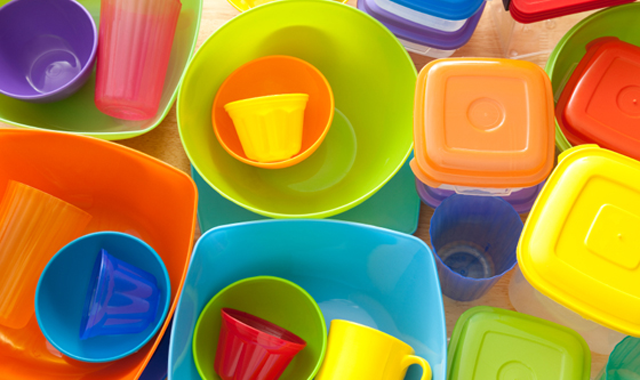By now, most of us have gotten the message that the less plastic we use, the better off our planet and bodies will be. By using less plastic, particularly in the kitchen, we can reduce our daily toxic loads simply by ingesting fewer of the chemicals that leech out of plastics when heated. So how to cut exposure in a plastic-wrapped world? Start by learning which plastics to avoid and how to use the rest as wisely. To start tapering off your plastic dependency, here’s what I suggest:
Say “No way BPA.”
Top of the heap to avoid: plastics containing Bisphenol A (BPA). They significantly increase the risk of certain cancers, numerous hormonal and reproductive problems, plus a host of other chronic diseases. To make matters worse, BPAs appear to be even more dangerous to babies and children, who are most often exposed to BPAs via certain types sippy cups, food containers, and toys. In short, there’s no good news whatsoever about BPAs, so steer clear of them.
Where do the BPAs lurk? Tucked into the linings of most metal cans, including canned foods and baby formula—a horrifying thought when you think about how long some canned items can sit on a shelf, leeching BPAs into your food! Where else? In containers marked “PC” (polycarbonate) and most containers marked with the recycling code “7.” Keep them out of baby’s mouth—and yours—by avoiding canned goods as well as hard, see-thru plastic baby bottles, sippy cups, and plastic water bottles. To drink in fewer toxins without giving up portability and convenience, buy only BPA-free baby bottles and water bottles.
Make yourself a glass act.
My ultimate prescription: Skip plastic altogether and store, cook, eat, and drink with all glass, all the time. If that’s not always feasible, at least be aware of what you’re bringing into your home. When buying food and beverage items, look for the recycling codes on the bottom of the container. If they’re tagged with a #1, 2, 4 or 5, they’ll be BPA-free, making those containers an okay choice for the short-term. Although #6 is BPA free, it is polystyrene, which I recommend you avoid as well as it is a possible carcinogen and toxic to the nervous system. When you get home from the store, decant purchases from their plastic containers into glass ones to stop further chemical leeching.
Hey what about number 3?
Give items marked with a “3” a wide berth! The seemingly innocuous number 3 actually denotes that the item is made of PVC, also known as vinyl, a notorious toxic off-gasser. You’ll see it most often in toys and plastic wraps. Avoid them both. If you bring home food wrapped in plastic wrap, remove it immediately and transfer the food into a glass container for storage. When cooking in the microwave, never use plastic wrap to speed heating or reduce splatters, cover items with a paper towel instead. Need an easy way to help remember the BPA bad boys? Make this your shopping mantra: PC-7-3—BPAs, not for me!
Treat your plastics right.
Think of it this way: Plastics—if you heat ‘em you eat ‘em. In other words, never cook or microwave in plastic containers, no matter how BPA-free they may be. Heating any kind of plastic, with or without BPAs, will increase chemical leeching and add to your toxic load. The heat ‘em/eat ‘em rule applies to cleaning plastics as well. A good rule of thumb is to hand-wash plastics with warm soapy water, non-abrasive sponges or dish towels and allow to air dry. Most dishwashers clean so hot that they help degrade the plastic and speed their breakdown, which again, will allow more leeching to occur.
Know when to say goodbye.
Know when it’s time to retire a plastic item. Though they may last forever in the landfill, it’s bad for your health to use them forever. When to toss? Take a close look. If an item is scratched, cloudy or battle-scarred from years of good service, decommission it to prevent tiny flecks of plastic from mixing into your food. Last but not least—never re-use single use-bottles, as they too are not designed to withstand repeated usage or repeated washings. Better yet, don’t buy single-use bottles in the first place for a healthier body and planet. My advice? Keep it glassy!
Dr. Frank Lipman is an acclaimed Integrative Physician and the founder and director of the Eleven Eleven Wellness Center in New York City. For over 20 years his personal brand of healing has helped thousands of people reclaim their vitality and recover their zest for life. Focused on sustainable wellness—instead of quick fixes—he offers patients a customized blend of Western medicine with acupuncture, nutritional counseling, vitamins and herbs, relaxation techniques, physical therapy, and bodywork. In 2010 he developed Be Well by Dr. Frank Lipman, a line of leading-edge supplements and health programs. He is the author of Revive: Stop Feeling Spent and Start Living Again and Total Renewal: 7 Key Steps to Resilience, Vitality and Long-Term Health.
For more on Dr. Lipman, please visit his resourceful WEBSITE or on FACEBOOK or TWITTER.












